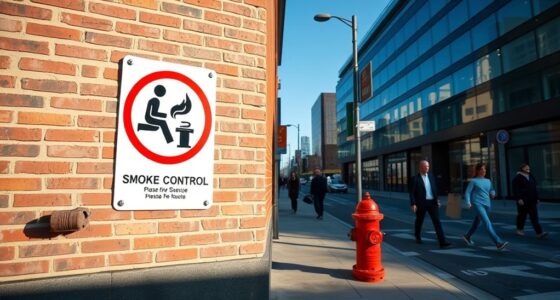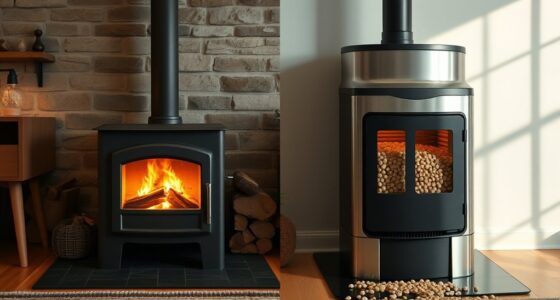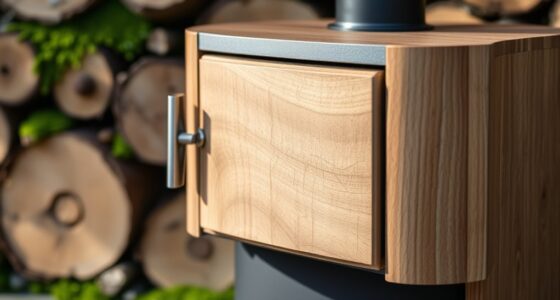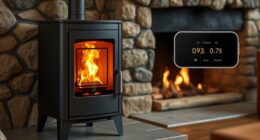Burning dry, seasoned wood improves your overall heating efficiency by producing more heat with less wood and reducing creosote buildup in your chimney. It also means less smoke and unpleasant odors, which helps keep your indoor air cleaner and safer. Plus, seasoned wood burns faster and steadier, so you won’t need to tend your fire as often. To learn how to maximize these benefits and save money, keep exploring the advantages of properly seasoned wood.
Key Takeaways
- Burning seasoned wood produces less smoke and creosote, improving air quality and reducing chimney fire risks.
- It heats up faster and provides a steady, more efficient heat output, saving fuel and energy.
- Properly dried wood emits fewer odors and pollutants, creating a healthier indoor and outdoor environment.
- Reduced moisture content leads to cleaner burns, less ash, and less chimney maintenance.
- Overall, it enhances combustion efficiency, lowers costs, and promotes a safer, cleaner fireplace experience.
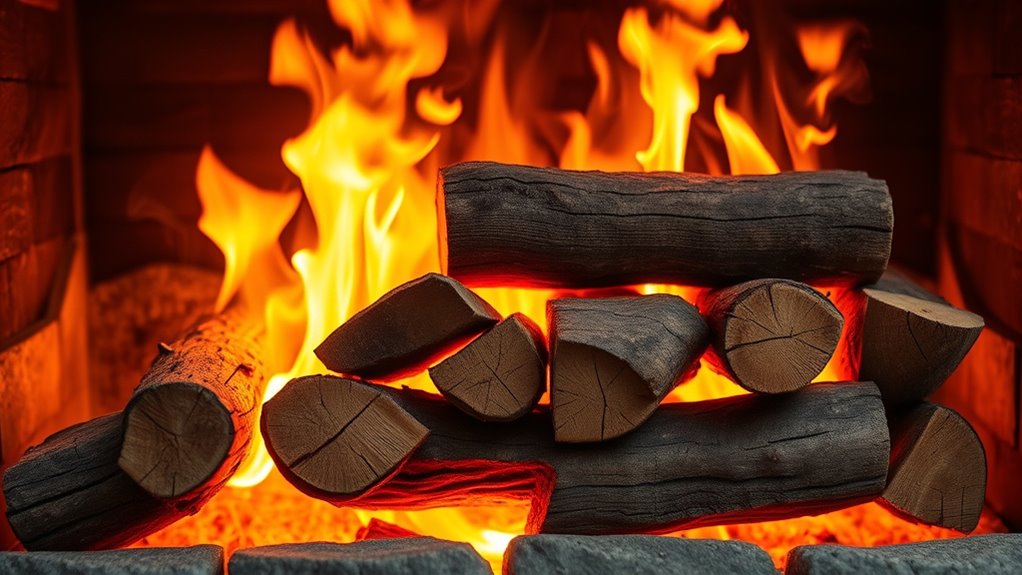
Burning dry, seasoned wood offers numerous advantages over unseasoned or green wood, making it a smarter choice for your fireplace or stove. One of the most significant benefits is its low moisture content. When the wood is properly seasoned, typically by drying for at least six to twelve months, it has a moisture level below 20%. This reduction in moisture is vital because high moisture content in wood hampers combustion efficiency. Green or unseasoned wood contains a lot of water, which must evaporate before the wood can burn effectively. This process consumes energy and results in a less complete and less efficient burn, producing more smoke, creosote buildup, and less heat output.
By choosing seasoned wood, you guarantee that your fireplace or stove operates at its highest efficiency. The lower moisture content allows the wood to ignite more easily and burn more thoroughly. When the moisture is minimized, the combustion process becomes cleaner and more efficient, meaning you get more heat from less wood. This efficiency not only saves you money on fuel but also reduces the amount of ash and soot produced, helping keep your chimney cleaner and lowering the risk of dangerous creosote fires. Additionally, seasoned wood produces less smoke, which improves air quality both inside your home and in the surrounding environment.
Another advantage of burning seasoned wood is that it heats up faster and maintains a steady, consistent fire. Because less energy is diverted to evaporating water, the heat generated is more direct and potent. This means you’ll spend less time tending the fire and more time enjoying the warmth. Seasoned wood also tends to produce less odor and fewer emissions, making your home a healthier space. Plus, since the combustion is more complete with lower moisture content, you’ll experience fewer unpleasant smells associated with incomplete burning, such as acrid smoke or damp wood odors. Using properly seasoned wood can also help reduce the formation of air pollutants that can affect respiratory health, as incomplete combustion produces more harmful emissions.
Frequently Asked Questions
How Long Does It Take to Properly Season Firewood?
It typically takes about 6 to 12 months to properly season firewood, depending on your climate and the wood type. During this time, you should reduce the moisture content to below 20%. To guarantee proper seasoning, stack your wood in a dry, well-ventilated area and check the moisture content regularly. Proper seasoning duration is key to burning efficiently and safely.
Can Burning Seasoned Wood Reduce Indoor Air Pollution?
You might think burning seasoned wood would worsen indoor air quality, but it actually reduces emissions. By choosing dry, seasoned wood, you lower smoke and harmful pollutants, making your home healthier. Ironically, what seems like a simple way to keep warm also helps you cut down on indoor air pollution. Emission reduction becomes easier, giving you a cleaner, safer environment while enjoying the cozy glow of your fire.
Is There a Difference in Heat Output Between Hardwood and Softwood?
You’ll notice a difference in heat output between hardwood and softwood due to their combustion properties. Hardwood generally has higher heat efficiency because it contains more energy per volume, providing longer-lasting, hotter fires. Softwood ignites quickly and burns faster but produces less heat overall. If you want sustained warmth, hardwood’s better. Softwood works well for quick heating, but for consistent heat, hardwood is your best choice.
How Should I Store Dry Firewood to Keep It Seasoned?
You should store your dry firewood in a well-ventilated area, off the ground, and protected from rain and snow. Use a wood rack or stack it with space between logs for good airflow, which helps prevent moisture buildup. Cover the top of the stack with a tarp or a roof, but leave the sides open to allow moisture prevention and guarantee the wood stays seasoned. Proper storage keeps your wood dry and ready to burn.
What Are the Signs That Firewood Is No Longer Seasoned?
You can tell firewood is no longer seasoned if its moisture content is high, typically above 20%. Look for visual cues like green or fresh bark, excessive moisture on the surface, or mold. If the wood feels heavy when you lift it or sounds dull when you knock two pieces together, these are signs it still holds moisture. Properly seasoned wood should feel dry, light, and produce a sharp, cracking sound.
Conclusion
So, next time you’re tempted to toss in that damp, unseasoned wood, remember the irony—you’ll waste more energy, produce more smoke, and end up with less heat. Burning dry, seasoned wood seems like such a hassle, but it actually makes your fire more efficient and eco-friendly. Ironically, neglecting the simple step of proper seasoning turns a cozy fire into a smoky, energy-draining ordeal. Sometimes, the best fire is the one you prepare with a little patience.




